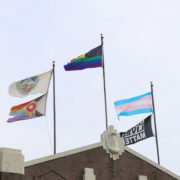
ww5.komen.org
Mammography screening is important for all women, regardless of their race/ethnicity or their risk of breast cancer.
Some women are less likely than others to get mammography screening.
There are many reasons for disparities in breast cancer screening in the U.S. Some are described here.
Learn about Komen’s work to end breast cancer disparities.
Health insurance
A main reason behind differences in mammography screening rates in the U.S. is health insurance.
Women who don’t have health insurance are much less likely to get mammograms than women with health insurance.
In 2013, among women ages 40 and older [7]:
- 38 percent of those with no health insurance had a mammogram in the past 2 years
- 70 percent of those with health insurance had a mammogram in the past 2 years
Although a lack of health insurance is a main reason for breast cancer screening disparities in the U.S., other factors play a role. Even among the women above with insurance, only 70 percent had a recent mammogram [7].
The Affordable Care Act requires all new health insurance plans (since September 2010) to cover yearly mammography (with no co-payment) for women ages 40 and older.
Learn more about Medicare, Medicaid and insurance company coverage of mammograms and find resources for low-cost or free mammograms.
Other barriers to breast cancer screening
Other barriers to mammography screening may include [7,77-81]:
- Low income (or worry about cost)
- Lack of access to care (such as lack of a local (or easy to get to) mammography center or lack of transportation to a mammography center)
- Lack of a usual health care provider
- Lack of a recommendation from a provider to get mammography screening
- Lack of awareness of breast cancer risks and screening methods
- Lack of child care
- Lack of sick leave or unable to miss work
- Fear of bad news or pain from the procedure
- Cultural and language differences
These may explain some of the disparities in mammography screening rates among certain populations of women, such as women from different racial and ethnic groups.
Race and ethnicity
Mammography screening rates in the U.S. vary by race and ethnicity (see Figure 3.6 below).
Figure 3.6
|
|
Percentage of women 40 and older |
|
Asian (non-Hispanic) |
67% |
|
Black (non-Hispanic) |
66% |
|
White (non-Hispanic) |
66% |
|
American Indian and Alaska Native |
63% |
|
Hispanic |
62% |
|
Adapted from American Cancer Society materials [7]. |
|
Asian-American, Native Hawaiian and Pacific Islander women
Asian-American women in the U.S. have somewhat higher rates of breast cancer screening than African-American and white women [7].
Asian-American, Native Hawaiian and Pacific Islander women also tend to have lower rates of breast cancer and breast cancer mortality (death) than African-American and white women [82].
However, breast cancer is the second leading cause of cancer death in Asian-American, Native Hawaiian and Pacific Islander women (lung cancer is the major cause of cancer death) [83].
African-American women
Overall, breast cancer incidence (rate of new cases) is slightly lower among African-American women than among white women [1].
However, breast cancer mortality is higher in African-American women (see Figure 3.7 below) [1,82-84]. For example, in 2013 (most recent data available), breast cancer mortality was 39 percent higher in African-American women than in white women [1].
Figure 3.7
|
|
|
Age-adjusted to the 2000 U.S. standard population. SEER Cancer Statistics Review: 1975-2013, 2016 [1]. |
Screening rates in the past
In the past, African-American women were less likely than white women to get regular mammograms [85]. Lower screening rates in the past may be one possible reason for the difference in survival rates today.
African-American women and white women now have the about same rates of mammography use [7].
In 2013 (most recent data available), among women 40 and older, 66 percent of African-American women and 66 percent of white women had a mammogram in the past 2 years (see Figure 3.6) [7].
Access to follow-up care
Access to follow-up care after an abnormal mammogram may explain part of the survival gap between African-American and white women.
Some, but not all, findings have shown that African-American women may have more delays in follow-up after an abnormal mammogram than white women [86-88].
Delays in follow-up may play a role in the lower survival rates among African-American women [84,89-90].
Other factors
Even after accounting for differences in income, past screening rates and access to care, African-American women are diagnosed with more advanced breast cancers and have worse survival than white women [89-93].
Differences in reproductive factors and breast cancer biology between African-American women and white women also appear to play a role in these disparities [84,93-96].
Learn more about factors that may impact breast cancer risk and survival among African-American women.
Age at diagnosis
African-American women also tend to be diagnosed at a younger age than white women [111].
The median age at diagnosis for African-American women is 59, compared to 63 for white women [111].
American Indian and Alaska Native women
American Indian and Alaska Native women (Native American women) have somewhat lower rates of breast cancer screening compared to white women [7].
Among women ages 40 and older, 63 percent of Native American women and 66 percent of white women had a mammogram in the past 2 years (see Figure 3.6) [7].
One reason for these somewhat lower screening rates may be access to care. Native American women tend to live in areas that require traveling a long distance to get health care, including mammography [97].
Breast cancer is the most common cancer among Native American women [1].
Native American women tend to have lower rates of breast cancer and breast cancer mortality than white or African-American women [82]. However, these rates vary according to where women live.
Native American women who live in Alaska have the highest rates of breast cancer (similar to non-Hispanic white women) and those who live in the Southwest have the lowest rates [98].
Hispanic/Latina women
Hispanic/Latina women have somewhat lower rates of breast cancer screening compared to other women, including non-Hispanic white women (see Figure 3.6) [7].
Some findings show Hispanic/Latina women may have a higher number of barriers to getting screening mammography than women of other ethnicities [81].
Hispanic/Latina women have lower rates of breast cancer and breast cancer mortality compared to non-Hispanic African-American and non-Hispanic white women [82,99].
However, breast cancer is still the most common cancer (and the leading cause of cancer death) among Hispanic/Latina women [99]. So, screening in these women is just as important as it is for African-American and white women.
Hispanic/Latina women tend to be diagnosed with more advanced breast cancers than white women [99]. This may be due to lower mammography rates as well as more delays in follow-up after an abnormal mammogram [99].
Lesbians and bisexual women
Some findings show the rates of screening mammography among lesbians, bisexual women and heterosexual women are similar [100].
However, other findings show lesbians and bisexual women may not get regular mammograms due to [101].
- Lack of health insurance
- Perceived low risk of breast cancer
- Past discrimination or insensitivity from health care providers
- Low level of trust of providers
One step lesbians and bisexual women can take is to find a provider who is sensitive to their needs. Networking with other women may be useful in finding such a provider.
Provider visits offer the chance to get health care, including breast cancer screening, on a regular basis.
|
Komen’s work in the lesbian, gay, bisexual and transgender (LGBT) community |
| Hear from Eric Brinker, often called Susan G. Komen’s longest-running volunteer, about how he supports Komen’s mission as well as advocates for improved breast cancer care for the LGBT community.
Learn how Komen is working to better serve the LGBT community. |
Physical disabilities and breast cancer screening
Women with physical disabilities tend to get mammograms less often than women without such limitations [102-103]. One reason is lack of access [104-106].
Many mammography centers (especially mobile ones) simply aren’t designed for women who have trouble getting around. Having a good experience increases the chances women with disabilities will return for routine mammograms [107].
If you have concerns about access, call the mammography centers in your area until you find one that meets your needs. Partnering with your health care provider in your search can make things go more smoothly.
The CDC also has a tip sheet for breast cancer screening for women with disabilities.
If access to mammography for disabled women is limited in your area, let your local medical centers know. This may help increase access for you and other women.
Getting involved
Disabled women themselves know best how to improve facilities, medical equipment and patient-provider relations.
Let your voice be heard by the larger community. If access to health care for the disabled isn’t as good as it could be in your area, let your local medical centers, health insurance providers and elected officials know.
About 27 million women in the U.S. have a physical disability [108], making a powerful group to lobby for change.
|
What is Susan G. Komen doing? |
| Susan G. Komen and the American Association on Health and Disability (AAHD) have worked together to address and remove barriers to screening and treatment for women with disabilities.
Komen and AAHD:
Recently, AAHD has been awarded a two-year grant to continue their work to address barriers for women with disabilities in Washington, D.C. through our National Capital Region Community Grants Program. Primarily, this program will target women with disabilities living in Wards 2, 5, 7, and 8 in the District of Columbia. The goal of the current project – Breast Cancer Awareness for Women with Disabilities – is to help reduce breast cancer disparities for women with disabilities by targeting the community, and health care providers in mammography screening facilities. AAHD plans to accomplish this through the dissemination of breast health educational materials, one-on-one education about breast health and by conducting accessibility assessments at screening facilities to determine the structural barriers that prevent women with disabilities from receiving their mammogram. |
Removing barriers to screening
Many barriers may make it hard for some women to get breast cancer screening and follow-up on abnormal mammograms.
Increasing access, awareness and sensitivity may help remove some barriers (especially for poor and uninsured women). This includes [78,109-110]:
- Improving access to mammography and primary care
- Removing financial barriers
- Removing language barriers
- Community education (such as health campaigns that address negative beliefs and feelings about mammography)
- Ensuring health care providers working with women from different communities and cultures are sensitive to their needs. (When a provider does not recommend a mammogram, some women do not feel they need one.).
If you are 40 years or older (and not at higher risk of breast cancer) and your provider does not bring up mammography, ask him/her to talk with you about screening and when and how often you should get a mammogram.
Learn more about talking with your health care provider.











